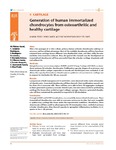Mostrar o rexistro simple do ítem
Generation of human immortalized chondrocytes from osteoarthritic and healthy cartilage
| dc.contributor.author | Piñeiro-Ramil, María | |
| dc.contributor.author | Sanjurjo-Rodríguez, Clara | |
| dc.contributor.author | Rodríguez-Fernández, Silvia | |
| dc.contributor.author | Hermida-Gómez, Tamara | |
| dc.contributor.author | Blanco García, Francisco J | |
| dc.contributor.author | Fuentes Boquete, Isaac Manuel | |
| dc.contributor.author | Vaamonde-García, Carlos | |
| dc.contributor.author | Díaz-Prado, Silvia | |
| dc.date.accessioned | 2023-01-20T07:36:52Z | |
| dc.date.available | 2023-01-20T07:36:52Z | |
| dc.date.issued | 2023-01-17 | |
| dc.identifier.citation | Piñeiro-Ramil M, Sanjurjo-Rodríguez C, Rodríguez-Fernández S, Hermida-Gómez T, Blanco-García FJ, Fuentes-Boquete I, et al. Generation of human immortalized chondrocytes from osteoarthritic and healthy cartilage. Bone Joint Res. 2023 Jan;12(1):46-57. | es_ES |
| dc.identifier.issn | 2046-3758 | |
| dc.identifier.uri | http://hdl.handle.net/2183/32368 | |
| dc.description.abstract | [Abstract] Aims. After a few passages of in vitro culture, primary human articular chondrocytes undergo senescence and loss of their phenotype. Most of the available chondrocyte cell lines have been obtained from cartilage tissues different from diarthrodial joints, and their utility for osteoarthritis (OA) research is reduced. Thus, the goal of this research was the development of immortalized chondrocyte cell lines proceeded from the articular cartilage of patients with and without OA. Methods. Using telomerase reverse transcriptase (hTERT) and SV40 large T antigen (SV40LT), we transduced primary OA articular chondrocytes. Proliferative capacity, degree of senescence, and chondrocyte surface antigen expression in transduced chondrocytes were evaluated. In addition, the capacity of transduced chondrocytes to synthesize a tissue similar to cartilage and to respond to interleukin (IL)-1β was assessed. Results. Coexpression of both transgenes (SV40 and hTERT) were observed in the nuclei of transduced chondrocytes. Generated chondrocyte cell lines showed a high proliferation capacity and less than 2% of senescent cells. These cell lines were able to form 3D aggregates analogous to those generated by primary articular chondrocytes, but were unsuccessful in synthesizing cartilage-like tissue when seeded on type I collagen sponges. However, generated chondrocyte cell lines maintained the potential to respond to IL-1β stimulation. Conclusion. Through SV40LT and hTERT transduction, we successfully immortalized chondrocytes. These immortalized chondrocytes were able to overcome senescence in vitro, but were incapable of synthesizing cartilage-like tissue under the experimental conditions. Nonetheless, these chondrocyte cell lines could be advantageous for OA investigation since, similarly to primary articular chondrocytes, they showed capacity to upregulate inflammatory mediators in response to the IL-1β cytokine. | es_ES |
| dc.description.sponsorship | The authors disclosure receipt of the following financial or material support for the research, authorship, and/or publication of this article: this work was supported by grants for Grupos con Potencial de Crecemento 2020 (ED431B 2020/55) and Grupos de Referencia Competitiva (IN607A2021/07) from Xunta de Galicia, by grants PI20/00933 and PI17/02197 from Instituto de Salud Carlos III-General Subdirection of Assessment and Promotion of the Research—European Regional Development Fund (FEDER) “A way of making Europe”; and PI19/01206 also by Instituto de Salud Carlos III (ISCIII), co-funded by ERDF/ESF, “A way to make Europe”/"Investing in your future". The Biomedical Research Network Center (CIBER) is an initiative from ISCIII. M. Piñeiro-Ramil thanks Universidade da Coruña (UDC), Ministerio de Universidades and the European Union (NextGenerationEU) for her postdoctoral contract (RSU.UDC.MS06). C. Vaamonde-García thanks Xunta de Galicia for his postdoctoral contract (grant number ED481D 2017/023). C. Sanjurjo-Rodríguez thanks Xunta de Galicia for her postdoctoral contract (ED481B 2017/029). S. Rodríguez-Fernández thanks Xunta de Galicia and European Union (European Fund of Regional Development) for her predoctoral contract (ED481A-2019/206). | es_ES |
| dc.description.sponsorship | Xunta de Galicia; IED431B 2020/55 | es_ES |
| dc.description.sponsorship | Xunta de Galicia; IN607A2021/07 | es_ES |
| dc.description.sponsorship | info:eu-repo/grantAgreement/ISCIII/Programa Estatal de Generación de Conocimiento y Fortalecimiento del Sistema Español de I+D+I/PI20%2F00933/ES/VESICULAS EXTRACELULARES PEQUEÑAS (SEVS): UNA NUEVA HERRAMIENTA TERAPEUTICA PARA EL TRATAMIENTO DE LA ARTROSIS | es_ES |
| dc.description.sponsorship | info:eu-repo/grantAgreement/ISCIII/Programa Estatal de Fomento de la Investigación Científica y Técnica de Excelencia/PI17%2F02197/ES/CELULAS MADRE PLURIPOTENTES INDUCIDAS (IPS) COMO MODELO DE ARTROSIS DE MANOS | es_ES |
| dc.description.sponsorship | info:eu-repo/grantAgreement/ISCIII/Programa Estatal de Generación de Conocimiento y Fortalecimiento del Sistema Español de I+D+I/PI19%2F01206/ES/VALIDACION CLINICA DE NUEVOS BIOMARCADORES PREDICTIVOS DE DIAGNOSTICO Y PRONOSTICO EN ARTROSIS: EL PROYECTO HPP | |
| dc.language.iso | eng | es_ES |
| dc.publisher | The British Editorial Society of Bone & Joint Surgery | es_ES |
| dc.relation.uri | https://doi.org/10.1302/2046-3758.121.BJR-2022-0207.R1 | es_ES |
| dc.rights | Creative Commons Attribution-NonCommercial-NoDerivs 4.0 International Licence (CC-BY-NC-ND 4.0) | es_ES |
| dc.rights.uri | http://creativecommons.org/licenses/by-nc-nd/4.0/ | * |
| dc.subject | Articular chondrocytes | es_ES |
| dc.subject | Osteoarthritis | es_ES |
| dc.subject | Cell immortalization | es_ES |
| dc.subject | Inflammation | es_ES |
| dc.title | Generation of human immortalized chondrocytes from osteoarthritic and healthy cartilage | es_ES |
| dc.type | info:eu-repo/semantics/article | es_ES |
| dc.rights.access | info:eu-repo/semantics/openAccess | es_ES |
| UDC.journalTitle | Bone & Joint Research | es_ES |
| UDC.volume | 12 | es_ES |
| UDC.issue | 1 | es_ES |
| UDC.startPage | 46 | es_ES |
| UDC.endPage | 57 | es_ES |
Ficheiros no ítem
Este ítem aparece na(s) seguinte(s) colección(s)
-
GI-TCMR - Artigos [130]
-
GI-GIRS - Artigos [100]






